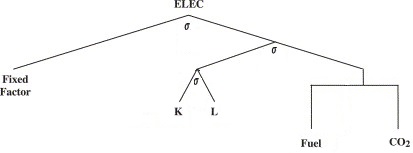Production system and representation of economic sectors - COFFEE-TEA
| Corresponding documentation | |
|---|---|
| Previous versions | |
| Model information | |
| Model link | |
| Institution | COPPE/UFRJ (Cenergia), Brazil, http://www.cenergialab.coppe.ufrj.br/. |
| Solution concept | General equilibrium (closed economy) |
| Solution method | The COFFEE model is solved through Linear Programming (LP). The TEA model is formulated as a mixed complementary problem (MCP) and is solved through Mathematical Programming System for General Equilibrium -- MPSGE within GAMS using the PATH solver. |
| Anticipation | |
The production system in TEA model is based on nested Constant Elasticity of Substitution (CES) functions. Representative consumers maximize welfare subject to budget constraint in each region. Such choices are determined by the parameters of substitution and transformation elasticities in the utility and production functions. The CES functions describe the substitution possibilities between factors of production and intermediate inputs in the productive process, in a least cost approach. The CES production function can be expressed by the following Equation 1:
where Y represents the output, A is a constant for productivity, is the share of input i and X is the factor of production (capital, labor, resources etc.). The elasticity of substitution is a positive constant . The CES production function leads to the linear production function as , to the Cobb - Douglas production function as , and to the production function with fixed proportions (Leontief) as .
Production functions follow a nested technological structure. For instance, the electricity production includes emission factors to account for the CO2 emissions, the fuel used to produce electricity, capital (K), labor (L) and other fixed factors, as shown in <xr id="fig:TEA_1"/>.
<figure id="fig:TEA_1">
</figure>.
As a CGE model, all the economic activity is consistently represented in the TEA model. The economic system is represented by 16 sectors in the TEA model.
| Agriculture | Energy | Industry | Transport | Services |
|---|---|---|---|---|
| Agriculture crops and vegetables | Coal | Iron and Steel | Transport nec | Services |
| Livestock | Crude Oil | Chemical rubber and plastic | Water transport | Dwellings |
| Electricity | Manufacture of non-metallic mineral products | Air transport | ||
| Natural Gas | Other manufacture | |||
| Petroleum products |
The production systems that are explicitely represented in the COFFEE model, as a partial equilibrium model, are the energy and land-use systems (described in the following sections). The economic sectors are exougenously represented through the demand projections from external sources.






